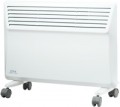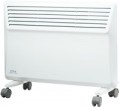Controls
- Rotary knob. Models with such mechanical control are inexpensive, but the possibilities of the control itself are rather limited and usually include only basic functions.
— Push-buttons. This type of control has more heating modes and additionally, there may be a display for showing information.
- Touch controls. It is similar to push-button models but has a more aesthetic appearance. It is found mainly in top models.
Features
— Thermostat. A device for maintaining a constant room temperature. In the presence of a thermostat, the heater can automatically turn off when the set temperature is reached and turn on when it drops by 1-2 °C.
— Temperature control. The ability to adjust the temperature of the air leaving the heater (in fan heaters and convectors), or the temperature of the heater body (in oil heaters).
— Emergency heating. This function does not protect the heater itself, but the room in which it is installed. When the frost protection is on, the heater automatically maintains the room temperature at 5 °C, turning on and off at the right time. This allows you to protect the walls of the room (for example, a country house) from freezing without the extra cost of electricity or gas.
— Sleep timer. A device for automatically turning off the heater after a predetermined time. The presence of a timer eliminates the need for the user to monitor the time and turn off the heater manually: knowing the approximate time required for heating, is enough to set the timer and the device will turn itself off at the right time.
— Weekly timer. The weekly timer allows you to organize the operation of the heater. Thanks to the weekly timer, you can set up automatic switching on and off of the heater, as well as temperature control depending on the time or day of the week. With the help of the weekly timer, you can set the heating in such a way that when the hea...ter goes to work, it will provide minimal heat, so long as the water in the pipes does not freeze, and shortly before the user arrives, it will begin to provide full heating. The programmer allows you to automate the heating process, while making it economical, rational and efficient.
— Turbo fan. The presence of an additional fan in the design of an oil heater or convector (see "Type"). Such a fan provides forced air circulation, which accelerates the heating of the room and increases the efficiency of the device. Note that fan heaters have this function by definition, so its presence is not indicated for them.
— Fan mode. The ability to operate a fan heater or other device with a fan (see above) in normal ventilation mode, when the heater is turned off and air passes through the device without heating. This mode can be useful, for example, in warm weather, when it is not necessary to warm the air. Of course, the efficiency of such devices is noticeably lower than that of full-sized specialized fans, but in many cases, it is quite enough.
— Oscillation. The system of automatic rotation of the heater body during operation. This allows you to increase the heating zone and provide more uniform heating of the room. Most often, fan heaters and infrared heaters are equipped with this function.
— Chimney effect. It is used in oil radiators to improve air circulation and faster heating of the room. Special slots are made on the body of the device, creating a draft and enhancing natural convection.
— Humidifier. An increase in indoor temperature leads to a decrease in relative humidity. This adversely affects the well-being of people. To prevent this, some models of heaters are equipped with air humidification devices, consisting of a water tank and an evaporator.
— Ionization. Ions are electrically charged molecules. It is believed that the presence of negatively charged ions in the air has a beneficial effect on the health and general well-being of a person. Ionizers are used to saturate the air with such ions.
— Remote control. The presence of a remote control supplied with the heater. The convenience of this function is obvious: the remote control allows you to control the heater from a distance. This is especially useful, for example, on a cold morning, when getting out from under the covers into a cold room would be extremely uncomfortable. Also note that in models with advanced functions (such as a timer), these functions often can only be controlled from the remote control.
— Control via smartphone. The ability to use the user's smartphone as a remote control. By installing the manufacturer's proprietary application, you can change the operating mode, and adjust the temperature and other device parameters directly from your phone.
— Wi-Fi module connection. The ability to expand the capabilities of the heater when connecting a Wi-Fi module (not included). With its help, control from a smartphone becomes available.
— Display. The presence of a display in the design of the heater. Usually, this is the simplest black-and-white screen with a few characters, but even this is enough in this case — almost all key information about the operation of the device can be displayed on this screen: temperature, timer settings, notifications about problems, etc. Thanks to this, control becomes more convenient and visual.
Safety system
— Overheat protection. The system of automatic shutdown of the heater when the critical temperature of the heating element is reached (which can happen, for example, if the fan heater motor fails). Ensures the fire safety of the device.
— Waterproof. The presence of a body protected from water splashes (most often sealed). Such heaters can be used in rooms with high humidity — for example, bathrooms — without the risk of short circuits or electric shock. However, even in such models, it is imperative to clarify the specific degree of water protection and restrictions on use before use; these data can be found in the instructions or other official documents of the manufacturer.
— Child lock. The control lock function prevents playful children or animals from changing the settings. Relevant for advanced devices with extensive management capabilities.
— Tip-over protection. A system that turns off the heater when it tips over to avoid fire or damage to the floor. This feature is especially relevant if there are small children in the house.
— Motion sensor. The presence of an appropriate sensor allows the device to focus on the presence of people and, by this, warm up the room. So, the absence of any movement in the "field of view" of the heater puts it into sleep mode. And the detection of movement (be it a dog or a person) reactivates it.
— Open window sensor. A special sensor allows the device to automatically recogni...ze when a window is opened for ventilation. In the process of airing the premises, the heater either turns off completely or switches to the most economical operation mode. This function allows you to save energy because, in the process of ventilation, the room heat will still evaporate into the street. Usually, the heating stop time is up to 30 minutes — in some models, the exact ventilation time can be adjusted by the user. The very fact of ventilation is most often fixed by the electronics. To do this, automation can use either traditional magnetic contact sensors or draft sensors (cold air inflow).

